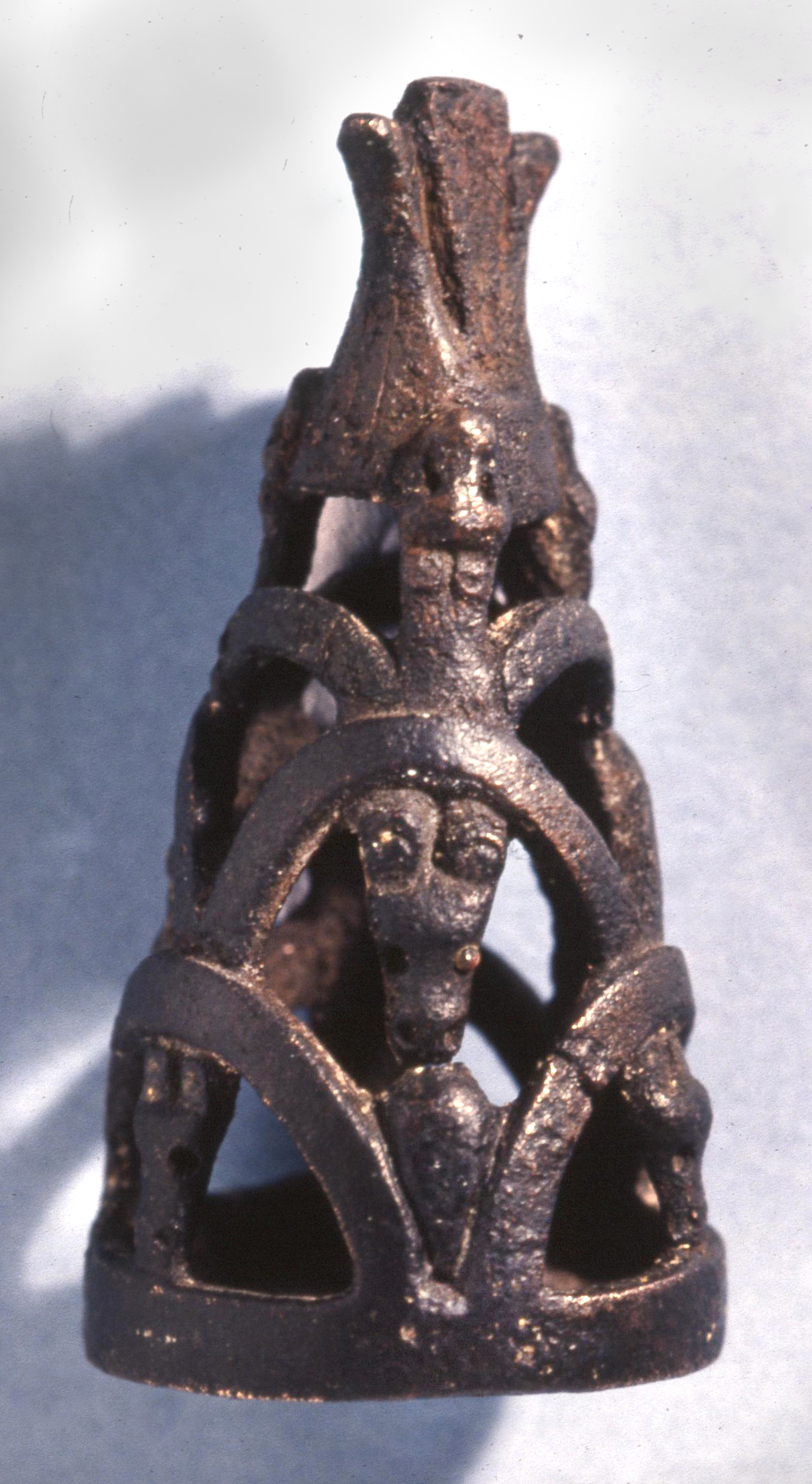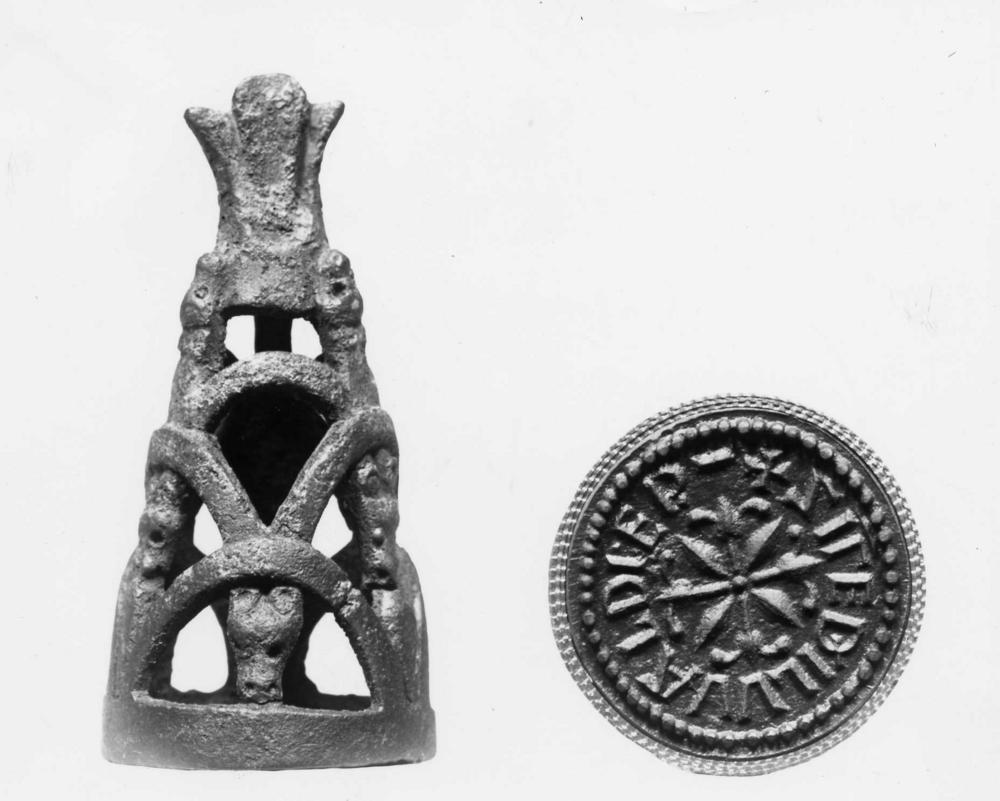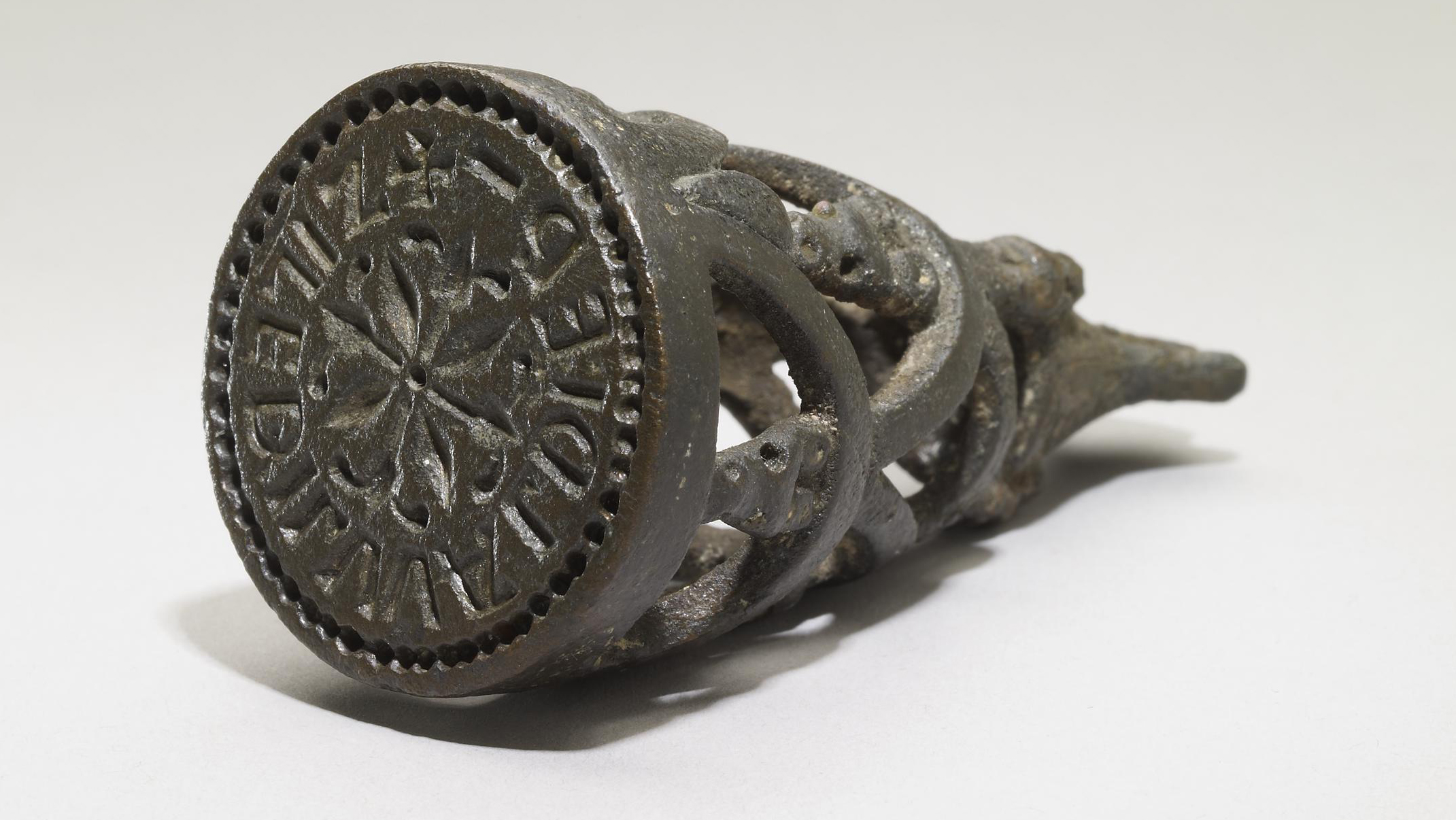Bronze seal of Bishop Æthelwald of Dommoc

Two hundred yards away from the monastery at Eye in Suffolk, a labourer in a garden unearthed a bronze seal that belonged to the Bishop Æthelwald of Dommoc, [1] which some believed to have been Dunwich. The monks of Eye owned the bishopric site of Dunwich until it was swallowed by the sea [2] and Æthelwald held office there from 845 to 870 approximately. [3] What makes this item a double ‘hidden history’ is both the fact that it is currently not on display in the British Museum as well as the mystery behind the objects design and inherent symbolism.
The bronze seal-die is mitre shaped and sub-conical with a Latin inscription that reads SIΓ EÐILVVALDI EP and is constructed of 2 tiered rows of 9 interlocking wolf heads which bite at the terminal, a solid triple leaf. It is stylistically similar to many zoomorphic heads on architectural sculptures and metalwork at the early medieval settlement around Deerhurst in Gloucestershire. [4] One of the animal heads on the seal still retains a minute inlaid red garnet eye, but why wolf heads, and why 9 of them?
There are 13 references to wolves in the bible that are usually used as metaphors to portray greed and destructiveness, [5] and in Genesis, the wolf uses intelligence and deviousness for selfish purposes. [6] The wolf was the symbol of pagan Rome, a culture in which Jesus lived and preached, indeed the Wuffing dynasty claimed to be direct descendants of Caesar and Odin. [7] “It was not long before the wolf became a symbol of evil” and a threat to those in Christ’s flock. [8] The Roman Church also used the image of the wolf as a devil that lurked among the Christian flock in the real world, giving the devil a physical presence on earth. [9] The symbol of the wolf looms large over Suffolk as the royal dynasty of the Wuffingas, the ‘people of the wolf’. [10] They travelled from Sweden and settled in this region before successfully ruling for many years, from Raedwald at Sutton Hoo c.617 – 625, King Beonna c.749-? near Butley, and then finally St Edmund c.853-869, the last descendant of the Wuffing kings who died in 869 for refusing to give up his Christian faith, before being tied to a tree and shot full of arrows before his beheading.
The number 9 is used 49 times in the bible and symbolizes divine completeness, conveying the meaning of finality. [11] Elsewhere, reference is made to there being 9 fruits of the spirit and 9 gifts of the spirit [12] and as a sacral number, 9 was the number of nights that a king, bishop or holy church could grant respite, should a thief need it, as declared by Æthelstan 894-939. [13]
The pre-Christian animistic worldview was one where nature was supernaturally charged, and animals were messengers from the otherworld. Pagan animism influenced the development of early Christianity and the material culture of the 7th century, which later had a brief resurgence in the 9th -10th centuries when these worlds collided spectacularly with the incoming Scandinavians. Introducing animal funerals and monumental expressions of their beliefs “the major cosmic player was the pagan wolf, rather than the Christian lion or dragon.” [14] Was the bronze seal a nod to the unwavering faith of the last of the Wuffing kings, or a symbol to always remind oneself to guard against and conquer ‘evil’?


References
- British Museum seal-impression, number 1822,1214.1 https://www.britishmuseum.org/collection/object/H_1822-1214-1
- Redstone, L. (1907-11) The Victoria County History of Suffolk, two vols.
- Wilson, D.M. (1964) Anglo-Saxon Ornamental Metalwork 700-1100 in the British Museum, Catalogue of Antiquities of the Later Saxon Period, I, London, cat. 18, 34.
- Webster, L. & Backhouse, J. (1991) The Making of England: Anglo-Saxon art and culture, AD 600-900 and Suffolk Heritage Explorer, Find Spot record EYE 009 – Findspot of an Anglo-Saxon bronze seal of Bishop Aethelwald of Dommoc. (Sax) https://heritage.suffolk.gov.uk/Monument/MSF451
- Wolves in folklore, religion and mythology. https://en.wikipedia.org/wiki/Wolves_in_folklore,_religion_and_mythology
- King, B. Wolf Symbolism and Meaning. https://whatismyspiritanimal.com/spirit-totem-power-animal-meanings/mammals/wolf-symbolism-meaning/#Christianity-Wolf
- Owen, G.R. (1981) Rites and Religions of the Anglo-Saxons
- Wollert, E. Wolves and Christianity. https://www.wolfsongalaska.org/chorus/node/347
- Jesse, L. (2000) Wolves in Western Literature. Chancellor’s Honors Program Projects. https://trace.tennessee.edu/utk_chanhonoproj/391
- Newton, S. (1993) The Origins of Beowulf and the pre-Viking Kingdom of East Anglia. Brewer.
- Garcia, K. (2022) The Meaning Of The Number 9 In The Bible And What It Represents. https://www.biblekeeper.com/number-9-meaning-in-the-bible/
- Daley, A. (2022) Biblical Number 9 – Significance, Appearance, And Symbolism In The Bible. https://joynumber.com/biblical-number-9/
- Chaney, W.A. (1970) The cult of kingship in Anglo-Saxon England: the transition from Paganism to Christianity. Manchester University Press.
- Pluskowski, A. (2007) The beast within. Breaching human-animal boundaries in Anglo-Saxon paganism. Saxon no. 45. David & Charles.
